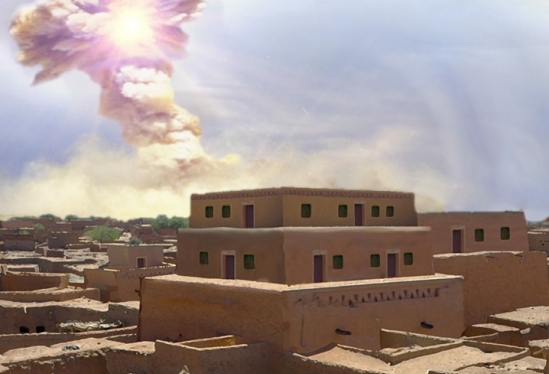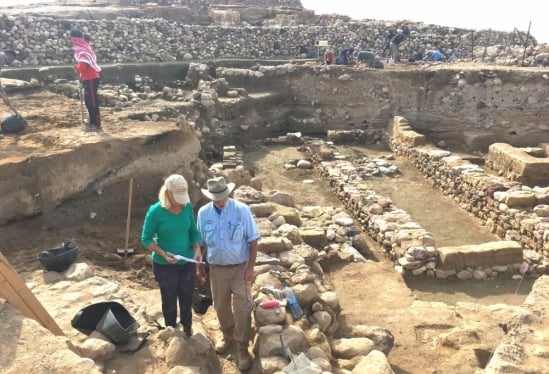
In the Middle Bronze Age (about 3,600 years ago or roughly 1650 BCE), the city of Tall el-Hammam was ascendant. Located on high ground in the southern Jordan Valley, northeast of the Dead Sea, the settlement in its time had become the largest continuously occupied Bronze Age city in the southern Levant, having hosted early civilization for a few thousand years. At that time, it was 10 times larger than Jerusalem and 5 times larger than Jericho.
“It’s an incredibly culturally important area,” said James Kennett, emeritus professor of earth science at UC Santa Barbara. “Much of where the early cultural complexity of humans developed is in this general area.”
A favorite site for archaeologists and biblical scholars, the mound hosts evidence of culture all the way from the Chalcolithic, or Copper Age, all compacted into layers as the highly strategic settlement was built, destroyed and rebuilt over millennia.
But there is a 1.5-meter interval in the Middle Bronze Age II stratum that caught the interest of some researchers for its “highly unusual” materials.
In addition to the debris one would expect from destruction via warfare and earthquakes, they found pottery shards with outer surfaces melted into glass, “bubbled” mudbrick and partially melted building material, all indications of an anomalously high-temperature event, much hotter than anything the technology of the time could produce.
“We saw evidence for temperatures greater than 2,000 degrees Celsius,” said Kennett, whose research group at the time happened to have been building the case for an older cosmic airburst about 12,800 years ago that triggered major widespread burning, climatic changes and animal extinctions.
The charred and melted materials at Tall el-Hammam looked familiar, and a group of researchers including impact scientist Allen West and Kennett joined Trinity Southwest University biblical scholar Philip J. Silvia’s research effort to determine what happened at this city 3,650 years ago.
The results have been presented in the Nature’s article entitled: “A Tunguska sized airburst destroyed Tall el-Hammam a Middle Bronze Age city in the Jordan Valley near the Dead Sea”
Salt and Bone
“There’s evidence of a large cosmic airburst, close to this city called Tall el-Hammam,” Kennett said of an explosion similar to the Tunguska Event, a roughly 12-megaton airburst that occurred in 1908, when a 56-60-meter meteor pierced the Earth’s atmosphere over the Eastern Siberian Taiga.
The shock of the explosion over Tall el-Hammam was enough to level the city, flattening the palace and surrounding walls and mudbrick structures, according to the paper. The distribution of bones indicated “extreme disarticulation and skeletal fragmentation in nearby humans.“

For Kennett, further proof of the airburst was found by conducting many different kinds of analyses on soil and sediments from the critical layer. Tiny iron- and silica-rich spherules turned up in their analysis, as did melted metals.
“I think one of the main discoveries is shocked quartz. These are sand grains containing cracks that form only under very high pressure,” Kennett said of one of many lines of evidence that point to a large airburst near Tall el-Hammam. “We have shocked quartz from this layer, and that means there were incredible pressures involved to shock the quartz crystals — quartz is one of the hardest minerals; it’s very hard to shock.”
The airburst may also explain the “anomalously high concentrations of salt” found in the destruction layer — an average of 4% in the sediment and as high as 25% in some samples.
“The salt was thrown up due to the high impact pressures,” Kennett said of the meteor that likely fragmented upon contact with the Earth’s atmosphere. “And it may be that the impact partially hit the Dead Sea, which is rich in salt.”
The local shores of the Dead Sea are also salt-rich, so the impact may have redistributed those salt crystals far and wide — not just at Tall el-Hammam, but also nearby Tell es-Sultan (proposed as the biblical Jericho, which also underwent violent destruction at the same time) and Tall-Nimrin (also then destroyed).
The high-salinity soil could have been responsible for the so-called “Late Bronze Age Gap,“ the researchers say, in which cities along the lower Jordan Valley were abandoned, dropping the population from tens of thousands to maybe a few hundred nomads.
Nothing could grow in these formerly fertile grounds, forcing people to leave the area for centuries. Evidence for resettlement of Tall el-Hammam and nearby communities appears again in the Iron Age, roughly 600 years after the cities’ sudden devastation in the Bronze Age.
Fire and Brimstone
Tall el-Hamman has been the focus of an ongoing debate as to whether it could be the biblical city of Sodom, one of the two cities in the Old Testament Book of Genesis that were destroyed by God for how wicked they and their inhabitants had become.
One denizen, Lot, is saved by two angels who instruct him not to look behind as they flee. Lot’s wife, however, lingers and is turned into a pillar of salt. Meanwhile, fire and brimstone fell from the sky; multiple cities were destroyed; thick smoke rose from the fires; city inhabitants were killed and area crops were destroyed in what sounds like an eyewitness account of a cosmic impact event. It’s a satisfying connection to make.
“All the observations stated in Genesis are consistent with a cosmic airburst,” Kennett said, “but there’s no scientific proof that this destroyed city is indeed the Sodom of the Old Testament.” However, the researchers said, the disaster could have generated an oral tradition that may have served as the inspiration for the written account in the book of Genesis, as well as the biblical account of the burning of Jericho in the Old Testament Book of Joshua. [Nature, USB, Conversation]
Now subscribe to this blog to get more amazing news curated just for you right in your inbox on a daily basis (here an example of our new newsletter).
You can also follow us on Facebook and/ or Twitter. And, by the way you can also make a donation through Paypal. Thank you!
You should really subscribe to QFiles. You will get very interesting information about strange events around the world.













Interesting the 3600 years ago number. Nibiru’s orbit takes 3657 years. Hmmm. Dr Immanual Velikovsky did a ton of research showing upheavals on earth every 3600 years or so.
Good point, Gary.
i researched this site back in the day.
the whole area was uplifted creating the dead sea and forcing the river that flowed from turkey to the red sea to go underground.
there’s a nice round structure a 100 kilometers around to the southeast of the dead sea, and 200 km away.
Since there is an abundance of Trinitite at the location, the “space rock” must be a new scientific name for a nuclear bomb!
Vaporized. Poof. No more heathen perverts. The evidence is right there plain as day.
https://www.westernjournal.com/liberals-sign-petition-tear-border-wall-flood-america-illegal-immigrants-replace-gop-voters/
Here’s a wild story about Sodom and Gomorrahfornia imbeciles. Same in most major blue crapholes, I suspect. Probably time for separation of red states from blue.
No telling when another cataclysmic event will occur in areas with major iniquities and abominations.
Probably had infanticide there 3,600 years ago. They ate the sacrifice too. Most people think the babies were just sacrificed.
Blood sacrifice cultures and pervert cultures get destroyed most of the time. Many examples of this occurring. Funny how people forget this, and repeat the same mistakes.
https://www.thegatewaypundit.com/2021/09/satans-power-defeated-tonight-high-school-football-team-defies-godless-school-board-gathers-team-prayer-field-following-game-video/
Mass Rebellion against satanist pedo godless heathens!
What a great story!